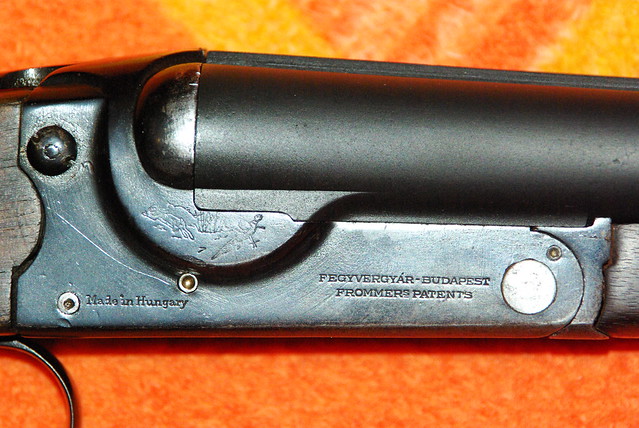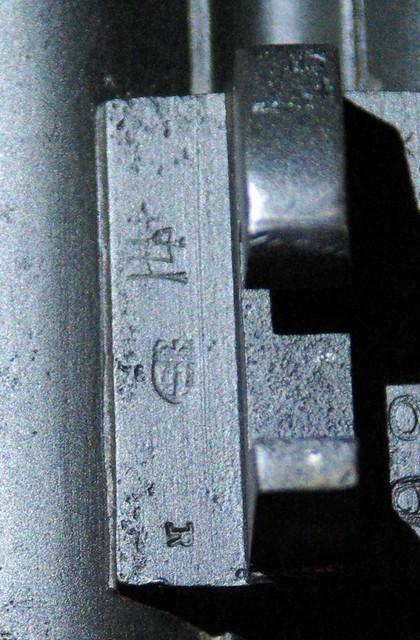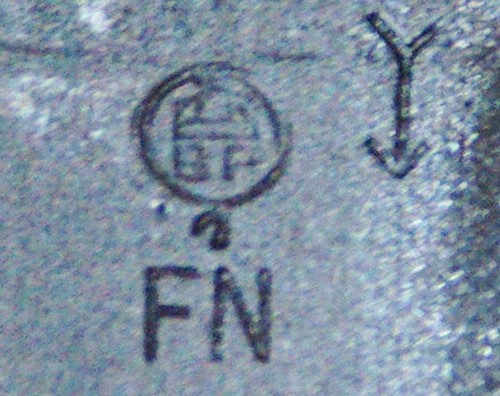Dear Shotgun Lovers,
I got an old Hungarian 16/65 double barreled shotgun made by the Hungarian "Fegyvergyár", as a heritage of my grandfather. Now I am on the way to find out, the exact type of it, when it was manufactured and what I should know about this gun. I made some pictures about the separate parts and about the proofmarks, which I cannot identify.
All what I could find out until now about this gun, that it was made with Belgian barrels, imported by Hungary, in order to export the ready guns to the USA after/around the WWII. The engravings on the left barrel are for the US Patent I think.
The serial number is 10380, exists somewhere a database, where I could find out the exact date of manufacturing?
If anyone could help me in these questions, I would be very thankful.
Best regards from Hungary,
Zoltán









Lovely set of Hungarian marks from 1930 and I'm not sure just how much info you desire. A start can be found here:
http://www.doublegunshop.com/forums/ubbt...true#Post179526I don't see any Belgian preliminary stamps so I'm curious as to how you know that the tubes were imported? It is possible that they could have been but both tubes wears the voluntary mark of tubes in the unfinished state. It seems there are some stamps forward of the flats but I cannot make them out. It was made in 1930 and returned in 1974, 1979 & 1985 for some Nitro reproof. For some reason I seem to recall that it was a condition of the law to return the sporting weapon when the law/rules changed. Maybe you can enlighten us here?
If you want to know all the marks I can begin with the St. Stephen's Crest and continue from there?
Kind Regards,
Raimey
rse
Hello,
I already read the topic You suggested, no question, there are some similarities.
To tell You the truth, I do not understand too much about proofmarks. I posted these photos to a Hungarian forum and they told there, the stamp FN should stay for the Fabrique Nationale, Belgium. They informed so, because there were some sets of shotguns, which were manufactured with imported Belgian barrels for export to the U.S. after the World War.
The problem is, that nobody can tell (enough) infos about the Fegyvergyár/FÉG in Hungary, because it stopped (went bankrupt) at the middle of the 90's and all databases of the factory lost and as far as I heard, the old 'gunsmiths' of the factory are a little bit incommunicative.
To the Nitro proof: as I know, it is true, what You wrote, there were a period, when the guns had to be controlled again and again on nitro, but nowadays they make it without any proofmarks or stamps.
Now, a Hungarian gun had to be checked every ten years on functionality and security. As far as I know, they check the status of the gun, if there are any visible mistakes/damages, they check the pressure (?), which is needed to pull the trigger (sorry, but I do not know the exact word for this) and they shoot with much more stronger loads to check the endurance of the gun barrels. After that the gun gets a plastic card (but no marks any more), which is like a proof-licence for the gun for the next 10 years. If somebody misses to renew it within 10 years, he can get big problems.
Back to the point: where can You see, that the manufacturing date was 1930?
I would be very happy, if I could read something about all of the proofmarks on this weapon, because on the internet there are not so many online. I hope, this is not too much expected :-)
Best regards,
Zoltán
No, not too much of a task. Just didn't want to bore you with a bunch of drivel. After WWI, Hungary is noted as continuing with the same Austro-Hungarian marks. Then on July 10th, 1928 they changed to what is seen on your sporting weapon to become more in line with the 1914 International Proof Conference. Starting at the forward end of the flats with what looks to be a set of antlers with a I in the center is the voluntary touchmark for tubes in the preliminary state or unfinished tubes. This mark coupled with the 15.7mm stamp makes me believe that the tubes were home grown and were proofed separate. For a sourced tubeset from another country one would expect to see a triangle with II in the center which is for an in the white tubeset. If the tubes had been 15.7mm on the final pass it would be 20 bore.
Next is the encircled Saint Stephen's crown over a BP which notes black powder proof. The "FN" below that isn't for Fabrique Nationale but for Füst Nelküli or smokeless proof. I'm not sure on the arrow beside these marks.
Next is the 1st past diameter which is 15.7mm followed by Nem Golyonak, which notes some degree of constriction/choke.
On the underside of the left tube is 1320 which notes the weight of the tubeset in grams. So it should weight 1320 grams. The "2" in it looks suspect and I wonder if the weight was altered at some point or if it was just a poor stamping.
On the underside of the right tube is 408/30 which makes the sporting weapons #408 to pass thru the Budapest proof facility in 1930.
The 16 over C in a rhombus is the chamber info that may have been adopted from some other proof facility. Typically it isn't listed for the Budapest facility but it may just be assumed.
The other touchmarks of the Shield with a N is a later Nitro proof effort. Here's a site with notes on Hungarian marks which appear to be taken directly from Gerhard Wirnsberger's proofmark text possibly with a few additions:
http://www.shotguns.se/html/hungary_1928_-_.html The other marks around the forend hanger are those of the mechanics which either made the tubes, knitted the tubes together to make a tubeset or actually made the sporting weapon. For now I'm not sure which craftsmen used which marks.
Kind Regards,
Raimey
rse
It is interesting because it has a U.S.A. patent number on top of the barrels, I can't quite make out the one, 1598_38. It would be nice to know what it is.
Should be this 1925 U.S. of A. patent #1558158:
http://www.google.com/patents?id=t5hEAAA...p;q&f=falseKind Regards,
Raimey
rse


S.P.I. sourced tubeset.
If the double had been imported into Hungary it would be similar to the flats below.
Some additional marks on a few Lampagyar variants:




The marks of the wreath/star/whatever was used from say 1949(1945??) to 1956/1957.

Kind Regards,
Raimey
rse
Thank you for the informations, I am very glad, that I could get such a rich knowledge to my gun.
What does unfinished-proof mean on a barrel?
I know the Monte Carlo and the Lámpagyári types, You posted, they were/are both one of the most used shotguns in Hungary.
I post 2 pics about the FÉG Victoria belonged to my father, but there must be other proofmark for the manufacturing date, because I cannot identify it. It should be from the 60's as far as I know


The remark "nem golyónak" means not for bullet. Normally, from these barrels You are not allowed to fire brenekke, because the choke is too tight.
Zoltán
Zoltan:
It is the same tubeset which passed thru the Budapest proof facility in 1967. Then again in 1978 & 1987. Also it appears that the weight was changed at some point or it is a very poor stamping effort.
Proof on an unfinished tube is just that. Separately tubes are taken to the proof facility with a hole less than the final diameter of the tube. I can't remember the exact number, but only a small amount can be polished away from the final diameter without being out of proof. After the 1st proof rules were enacted, wagon loads of single tubes were take to the proof facilities possibly in an attempt to prevent the loss of a tube in a tubeset if one of the tubes failed.
True, nem golyonak means not for bullet but the reason is that there is some degree of constriction. Common stamps are:
Not for Ball
Non Pour Balle
Nem Golyonak
Jen Pro Broky
Nicht Für Kugel
The reason they are applied is to note constriction and as you say do not pair well with some slugs.
Kind Regards,
Raimey
rse
Hello Raimey,
thank you , really, I missed the slash between the numbers, now it is clear. I would like to thank you for your really rich help on my questions, it is funny, that about Hungarian guns You can get the most informations from the USA :-)
If I could do/search/photo something from Hungary for You or for somebody in this forum, you can contact me everytime.
Zoltán
Zoltan - thanks for sharing a couple interesting guns with us.
I think we would all be interested in learning about hunting in Hungary. I've seen a couple ads for bird hunting there and would like to learn more.
And welcome to the site.
Hello Dave,
thank you. It is not too easy to write about everything in a topic, like hunting in Hungary. Is there any speciality, which You are interested in?
If You would like to be a hunter, You have to make a three step examination, on law, gun-handling and knowledges about the animals. After that You have to get some licences from the doctor, and from the police, in order to buy a gun. After that You have to buy the licence for hunting in Hungary. And if You have all of this, you can hunt as a member in a hunting association or as a guest somewhere. In Hungary hunting costs a couple of money :-))
Normally, in Hungary there is a list of animals, which You can hunt throughout the whole year or only in the periods, written in the law. Animals, like for example fox, wild-pig, or badger or magpie You can hunt all over the year. For the different deer cultivars, divided on sex and trophy, there is only a period, when You are allowed to shoot (for example between the first of September and 31 of October).
Bird hunting is not the same, like ages ago. The growing and caring of wild birds become more and more importance, but large amounts You can only shoot there, where You pay for it and where the birds are left free, exactly before their hunt. I cannot explain it better, sorry for it.
The historical abundance of the wild birds or rabbits in Hungary is already over, if You want to shoot a lot of them, You have to pay very very much. For example on places like these: shooting a rabbit costs 35€/piece, a pheasant 18€/piece. You can imagine, how much money you can give out, if you want to hunt at such places.
If You are a member in a hunting association, which have an area where they are allowed to hunt, You can shoot free birds or rabbits, but there are not so many.
OK, now I have to go working, if I can write more about something, please, let me know.
Zoltán
And the tubes are most likely NOT from Germany- there a "Nicht Fur Kugel" stamping would indicate the same thing. Interesting the shape of the ejector blade 'tails' and also the two set-screws on the water table-
I have been bird hunting in Hungary three times over the last 10+ years, most recently last October. Each time a different outfitter / location. In 2001, we finished up the hunting by staying in the hunting lodge of Janos Kadar, the head of government, and the person who betrayed the country during the 1956 revolution.
Each one of these experiences was outstanding, which is why I have kept going back.
Rob Schaul
Yes the tubes are from Hungary, it was cleared up, but I thought first they were from Belgium.
I saw some FEG shotguns and the structure is overall the same, it does not matter they are from the 40-s or from the 70-s. What do You understand on set crews on the water table? Which part You mean with this? Perhaps I can clear You up, what they are for.
Zoltán
Zoltan:
Francis may be looking at ejectors/extractors on the Lump images I posted but I think they are the same. Glad to offer some info and I'll take up on the research effort there in Hungary, possibly in the form of a raincheck. Marks of any and all Hungarian doubles would be interesting to me as well as the info on any of the gunsmiths from Budapest to Bucharest, Romania. Have you seen many Romanian sporting weapons?
Kind Regards,
Raimey
rse
Hi,
OK, if I can help somehow, let me know. Until then, I try to make some photos about the Hungarian guns oy my colleagues, about proofmarks etc.
I do not know and have not seen any Romanian shotguns until now. I have a pal in Romania, I try to contact him and ask for some pictures, he has some friends, who are hunting.
Zoltán
The folks at FEG do some interesting things. Here is a FEG Model 100-S 12 gauge box lock, and its fore end:


The device inset in the body of the fore end is the ‘kicker’ which makes gun a box lock ejector (BLE). But if that assembly is removed:

And the fore end re-installed, the gun becomes a box lock non-ejector (BLNE); an extractor only gun. That’s a nice feature to have. If one is involved in a driven hunt when the birds are coming fast and hard, ejectors are worth their weight in gold. But if we are shooting skeet where it is polite to pick up one’s expended hulls, then extractors are just the ticket.
But the creativity of the folks at FEG doesn’t end there. Here is a FEG 16 gauge SxS:

Note the plunger behind the trigger guard and the absence of a top lever. The plunger does the function of the missing top lever. The fore end of this gun also has the separate ejector assembly:

Here is a top view of the gun, where the absence of a top lever is especially obvious:

Note the push through button just behind the breasts of the standing breech. This button controls whether the safety is automatic (goes to the ‘ON’ position when the action is opened), or manual (remains in whatever position the shooter last set it). Also a nice feature, and allows the hunter to have an automatic safety when in the field, and the clays shooter to have a manual safety that doesn’t crimp his style.
Almost forgot to add: left barrel is choked Cyl, right barrel is choked IM. That's not a typo, front trigger fires an IM bbl, rear trigger fires a Cyl bbl.
Wild stuff.
I'm sure many have seen more than I. These guns also have vertical dovetail chopper lump barrels. Are there any other guns that have this besides the Winchester 21?
I had a 1970 Monte Carlo with excellent barrel regulation and choked .005 and .015 in 12 gauge; a real bird getter. One of my grandsons now has it.
Here is a pic of my 1973 Feg Continental with a view of the "chopper lump" barrels. Gun is still like new.


Hi,
a really nice gun, congratulations. May I ask You, how it succeded to buy it in the USA? Because I think in the 70's it was very difficult to import from the Soviet block or to export from the Soviet block to the USA. Is there a history of it?
Thank You,
Zoltán
Hello Kyrie,
yes, all FEGs I have seen until now, have removable ejectors, I think this is patented.
I would like to ask You something: can You post some other pictures about the gun on the third picture in your post (where the ejector is removed)? My gun has an ID, which is very next to this ID in the picture and I would like to see, whether there are some differences on form, proofmarks etc.
Thank you,
Zoltán
Hi,
a really nice gun, congratulations. May I ask You, how it succeded to buy it in the USA? Because I think in the 70's it was very difficult to import from the Soviet block or to export from the Soviet block to the USA. Is there a history of it?
Thank You,
Zoltán
The Feg Continental was bought in Canada. I really don't know any of its history. I just acquired it last summer from a gunsmith acquaintance of mine. He said a school teacher traded it in and that it had belonged to his father. So it could be that the gun was brought from Hungary by the father.


































